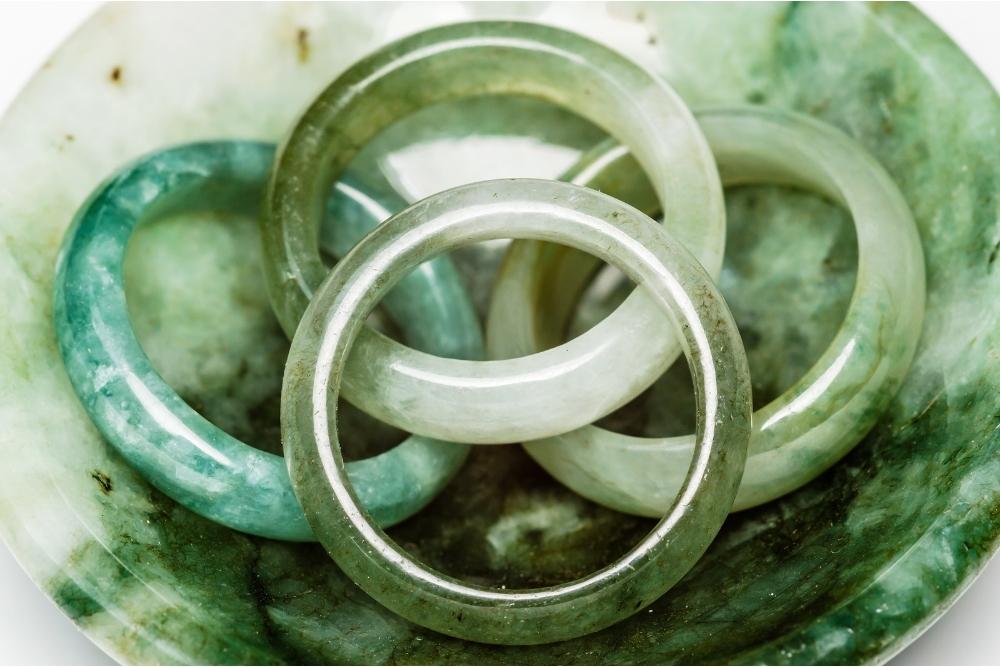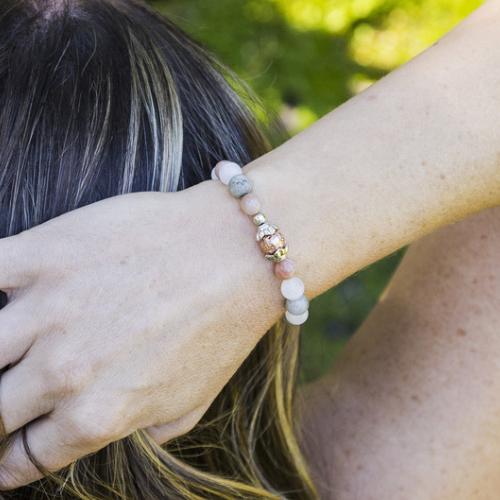
Green Jade: Healing Properties, History, and Benefits
Share
Table of Contents
What is Green Jade?
Jade is a beautiful gem that can come in as many colors as there are in the rainbow. But green is usually the color that comes to mind when someone says Jade. This popular stone has been widely used in jewelry and ornamental carvings dating back to prehistoric times.
Nowadays Jade can refer to two different types of minerals: Nephrite and Jadeite. Nephrite is made of a calcium magnesium silicate and ranges from translucent to opaque. It measures 6.0 on the Mohs hardness scale. Jadeite is a sodium aluminum silicate which ranges from transparent to opaque. It measures 6.5 to 7.0 on the Mohs hardness scale making it slightly harder than Nephrite Jade. This article won’t delve too deeply into the differences between Nephrite or Jadeite except where it’s important.
Green Jade can be found all over the world and is mined primarily in Australia, Canada, China, Japan, Myanmar, New Zealand, Poland, Russia, and the U.S.A.
In Eastern cultures, Jade is known as a stone of five virtues: kindness, righteousness, wisdom, bravery and purity. It is also referred to as Yu in Chinese, meaning gem or precious stone. Jadeite, the rarer variety of Jade, is also known as “Imperial Jade”.
Green Jade is known for its powerful protective and calming properties. In Chinese culture, people wear Jade to ward off bad luck and bring wealth, harmony and longevity.
Spiritual Meaning of Green Jade
For many cultures green is the color representing wealth, harmony, growth and the environment. For Eastern Asian cultures, green is also associated with luck, fertility and longevity.
Jade is known to bring luck, wealth, peace and good health. In Chinese culture, Green Jade jewelry such as necklaces and bangles have been traditionally gifted by mothers to daughters. It is believed to bring good fortune and provide protection from bad spirits.
Green Jade is the birthstone for March and is one of the zodiac stones for those born under the sign of Virgo (August 23 - September 22).
Green Jade in Ancient History & Lore
Green Jade has been mined and used in ornaments in China since the Stone Age. It wasn’t until 1863 that a French mineralogist realized that what was referred to as “jade” was really either Nephrite or Jadeite.
Jade has been carved into tools, weapons, jewelry, ornaments and sculptures throughout history in Asian cultures since the prehistoric ages. Highly skilled artisans would present the best Jade pieces to the Chinese Imperial court for consideration, hence the name Imperial Jade. Green Jade has traditionally been a symbol of status and wealth.
An old Chinese proverb says “Gold has a value; jade is invaluable.” But the Chinese weren’t the only ones who valued Jade more than gold. The Aztecs did too. When the Spaniards arrived in the Aztec capital of Tenochtitlan, they found that Jade use was reserved for the adornment of gods and royalty.
Green Jade is also associated with the dead. Ancient Mesoamerican cultures such as the Olmecs, Mayans and Aztecs would use Green Jade as burial artifacts, placing Green Jade in the mouths of their departed. During the Han Dynasty in China, the family of the deceased would place Jade pigs in the hands of the dead.
Healing Properties of Green Jade
Green Jade is not just a pretty green rock – it's also a powerful cleansing stone used in rituals and holistic medicine dating back centuries.
Metaphysical Healing Properties
Green Jade is primarily associated with the Heart Chakra, for love. Crystals that unblock the Heart Chakra are perfect for those seeking love and to heal matters of the heart.
The Heart Chakra is responsible for forgiveness, compassion and love. When the Heart Chakra becomes blocked, we find ourselves feeling lonely and unable to trust others. Our ability to feel trust and compassion is vital to our ability to love others. Green Jade is perfect for unblocking the Heart Chakra because of its warm vibrational energies.
Wearing Green Jade accessories or keeping Green Jade at home, whether as a sculpture or ornament, is perfect for warding off bad luck and bringing wealth, harmony and longevity into your life and household.
Physical Healing Properties
Traditionally Jade has been used in Chinese holistic medicine dating back centuries. It is believed to help heal problems in the heart, kidneys and central nervous system. Jade can also be used to alleviate muscle pain as well as improve blood circulation.
Emotional & Mental Healing Properties
Green Jade is an incredibly powerful calming stone that brings harmony and peace to your heart and mind. The stone is perfect for soothing depressing and anxiety, allowing you to completely open yourself up to others so that you can feel their love and compassion.
How to Use Green Jade
Add Green Jade to Your Daily Beauty Routine
Try using a Jade roller for a few minutes a day right after washing your face and applying moisturizer for improved circulation and reduced inflammation. Experts say it is a great way to promote healthier skin since the rolling motion helps improve blood flow and oxygen to your face and eliminates toxins.
Place Green Jade in Your Home for Better Feng Shui
The ancient tradition of Feng Shui focuses on the harmony between an individual and its environment. By arranging a room or living space in a certain way, you can balance and harmonize an individual and its surrounding environment.
Green Jade is believed to be a stone of good fortune. So to improve the Feng Shui in your house or workplace, try placing a Green Jade ornament or sculpture in the southeast corner to bring good luck and health to your family or business.
Green Jade Zodiac & Birthstone
Green Jade is the birthstone for March and is the perfect zodiac stone for Virgos. Virgos are known to be slowpokes when it comes to falling in love. They struggle to feel worthy, safe, or lovable. Jade balances the Heart Chakra, allowing Virgos to find love through trust and compassion.
How to Cleanse & Charge your Green Jade
Cleansing and Charging your Green Jade can be easy. One way is to leave it in direct sunlight for a couple of hours. As long as the Jade is not dyed or color enhanced, its color will not fade even under excessive heat and sunlight.
Another method is to leave your Jade crystal in direct moonlight. We recommend leaving your Green Jade in the moonlight overnight and then bringing it indoors in the morning. This way you can charge your stone in both moonlight and sunlight.
How to Care for your Green Jade
Green Jade is easy to care for especially because of its hardness rating (6.5 to 7.0 on the Mohs hardness scale). You should clean it with mild soap and warm water and then let it dry thoroughly like with most gemstones. You can use a toothbrush for scrubbing but stay away from harsh chemicals and abrasive materials. If your Green Jade is dyed, it’s best to keep it away from prolonged exposure to the heat or sunlight as the color tends to fade much faster.
Frequently Asked Questions About Green Jade
How to Identify Authentic Green Jade?
Below are the five best ways to tell if your Green Jade is real or not.
- Temperature Test Authentic Jade should be cool to the touch even in a warm environment. You can test it by holding it in your hand until it warms up. Set it down for a few seconds and then pick it up again. If the Jade is real, it would have cooled down and be cool to the touch again.
- Sound Test You can tell if Jade is real by listening to the sound it makes. Try lightly tapping your piece against a Jade piece you know to be authentic. True Jade will have a deeper more resonating sound compared to glass or plastic, which has a more muted and hallow sound.
- Weight Test Jade has a specific gravity of around 3.30. Glass on the other hand has a specific gravity between 2.40 to 2.80 and Green Aventurine, which is commonly confused with Jade, has a specific gravity between 2.60 to 2.70. The difference is that Jade should feel heavier than glass or Green Aventurine.
- Flaw Test Hold your Green Jade to the light and look for inconsistencies. If the color of your stone is flawless or too consistent, chances are the stone is not real. Authentic Jade should have vein-like fibers and minor imperfections.
- Scratch Test Green Jade is quite durable and should not scratch easily. For example, Nephrite Jade measures 6.0 on the Mohs hardness scale and Jadeite measures 6.5 to 7.0. A copper penny on the other hand has a Mohs rating of 3.0. Try scratching your Jade’s surface with a penny. If it leaves a clear mark, then the Jade is fake.
What is the Difference Between Green Jade and Green Aventurine?
Green Jade and Green Aventurine are both dazzling green gems that are thought to be lucky stones. Unlike Green Jade however, Green Aventurine belongs to the Quartz family and can be distinguished from Green Jade by its glittery surface. Green Jade should also feel heavier than Green Aventurine due to its higher specific gravity (3.30 versus 2.60 to 2.70).
Is Green Jade Expensive?
For Jadeite, the deeper the green color and the more translucent the material, the more expensive it is. Modern collectors are willing to pay top dollars for the best quality Jadeite, with some pieces fetching millions of dollars at auctions. Nephrite Jade on the other hand is more common than Jadeite and is generally considered less valuable with the exception of “mutton-fat” Nephrite, a white jade that is highly coveted.
Can Green Jade be in the sun?
Yes. Your Green Jade jewelry can sunbathe with you as long as it has not been dyed or color enhanced. The natural green color of Jade will not fade even with excessive exposure to the sun and heat.
Why did my Green Jade turn white?
Green Jade that has been dyed or heat treated for color enhancement will fade overtime and eventually turn white if exposed to excessive heat or sunlight. Jade that has not been color enhanced will not turn white.





